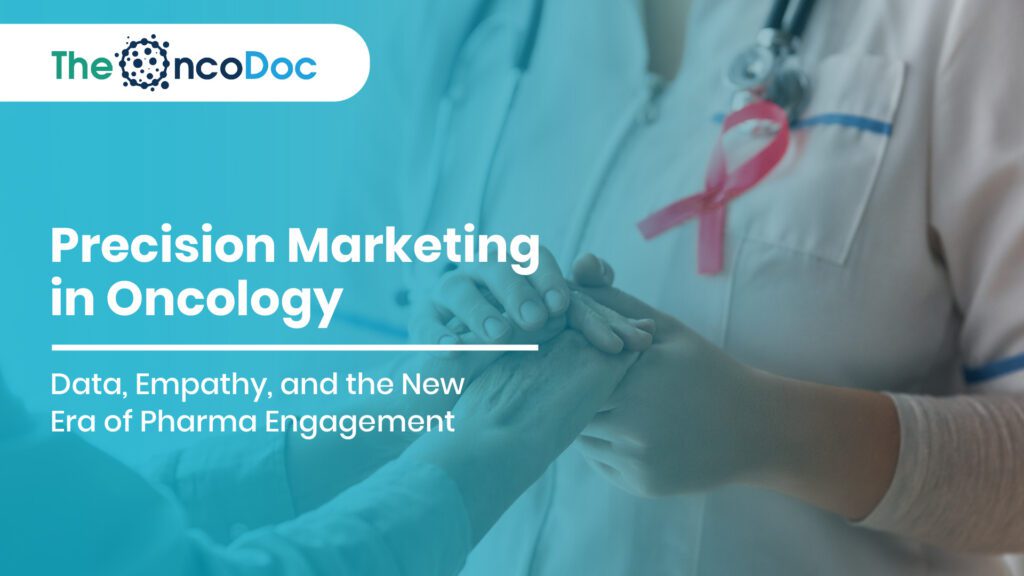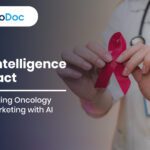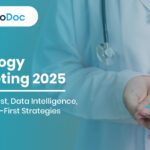Introduction: From Promotion to Purpose
The pharmaceutical industry’s role in oncology is no longer confined to product promotion. The new mission is to create systems that enable early detection, empower oncologists, and educate patients. The oncology marketing landscape is rapidly transforming from traditional one-size-fits-all campaigns to hyper-personalized interventions powered by artificial intelligence (AI), data analytics, and behavioral insights.
In India, for instance, 70% of cancers are diagnosed at advanced stages, where treatment options are expensive, and survival rates decline sharply. This calls for early intervention strategies where pharma marketing acts as an awareness engine rather than a mere promotional tool.
1. The New Context of Oncology Pharma Marketing
Modern oncology marketing is deeply patient-centric and prevention-focused. Instead of pushing brand narratives, companies are prioritizing educational content to help both healthcare providers (HCPs) and patients recognize early signs of cancer.
Pharma companies are shifting their lens from product-centric marketing to ecosystem-centric impact, where the aim is to bridge information gaps, build trust networks, and support timely clinical decisions.
2. From Digital Saturation to Data-Led Relevance
In today’s information-saturated environment, oncologists are bombarded with promotional content daily. What makes one campaign stand out? Data relevance.
- AI-powered CRM tools track digital footprints and preferences of HCPs, ensuring that each interaction feels relevant and valuable.
- Real-time analytics help in tailoring region-specific cancer awareness campaigns, delivering only what resonates with that audience segment.
- Predictive algorithms monitor behavioral cues, enabling timely content adjustments.
This data-led personalization transforms marketing into a meaningful conversation rather than digital clutter.
3. Understanding the Oncology Funnel
Oncology’s marketing funnel differs significantly from other therapeutic areas because of its emotional complexity. Patients go through stages of fear, denial, and uncertainty before taking action.
The funnel involves:
- Early Symptom Recognition – Informing patients about suspicious symptoms.
- Consideration Phase – Nudging them to consult primary care physicians (PCPs).
- Screening & Referral – Educating GPs to make timely referrals to oncologists.
- Treatment Awareness – Providing oncologists with the latest research-backed treatment guides.
- Post-Treatment Engagement – Supporting survivors with holistic care.
Pharma marketers must design targeted strategies for each funnel stage to ensure patient journeys are smooth and timely.
4. Engaging General Practitioners (GPs) – The True Gatekeepers
General practitioners play a pivotal role in early cancer detection. However, due to a lack of oncology-specific awareness, many cancers go undetected until advanced stages.
Pharma marketers are:
- Creating vernacular micro-learning platforms for GPs via WhatsApp and mobile apps.
- Organizing AI-driven diagnostic training webinars to highlight “red flag” symptoms.
- Supplying simplified referral protocols for high-risk cases.
5. Behavioral Marketing – Nudges That Save Lives
Behavioral economics is now embedded in oncology marketing. Rather than bombarding patients with heavy medical jargon, pharma marketers use nudges to encourage positive action.
Examples include:
- Location-based screening reminders sent to smartphones.
- AI chatbots in regional languages prompting users to check symptoms.
- Interactive quizzes or risk calculators shared on social media.
These micro-interventions lead to significant increases in screening attendance and GP consultations.
6. Emotional Storytelling – When Patients Speak, People Listen
Authenticity is the currency of trust. Survivors sharing their real stories of struggle and triumph inspire others to act.
Pharma campaigns featuring regional survivor videos have shown 30–40% higher engagement compared to traditional campaigns. The key is empathy, not statistics.
7. Data-Driven Personalization – Beyond Demographics
Generic campaigns don’t work anymore. Data analytics now allows for behavioral segmentation, such as:
- Users who engage with content but never visit a clinic.
- Patients who repeatedly search for symptoms like “unexplained weight loss.”
Personalized nudges-via WhatsApp, SMS, or email-convert awareness into timely medical action.
8. Hyperlocal Campaigns – Winning the Regional Game
A Marathi breast cancer campaign will resonate in Pune, but not in rural Assam where oral cancers dominate. Geo-targeted marketing ensures relevance, efficiency, and higher ROI.
Strategies include:
- Regional influencers driving local cancer awareness.
- District-level digital click-through campaigns tuned for cultural nuances.
9. The Role of Voice & Vernacular AI
Voice search is on the rise, with over 500M Indians using voice assistants. Pharma companies now deploy voice-first cancer screening tools, including:
- Voice-based cancer FAQs.
- AI-powered helplines for rural communities.
10. Collaborating with Key Opinion Leaders (KOLs)
Micro-KOLs (regional doctors, nurses, or social health workers) often influence more trust than national celebrities. Pharma companies are tapping these voices for hyperlocal impact.
11. Metrics That Truly Matter
The new marketing KPIs measure health impact, not just visibility:
- Screening registrations.
- Referral patterns of GPs.
- Patient engagement through bots or webinars.
12. Digital Ecosystems for Oncologists
Modern oncologists are bombarded with research papers, clinical updates, and treatment guidelines. To help them save time and focus on patient care, pharma companies are building digital ecosystems tailored to oncologists.
Key features include:
- AI-curated summaries of new oncology research to avoid information overload.
- Interactive treatment dashboards that compare the latest targeted therapies.
- Patient adherence tracking, so oncologists can intervene when treatment schedules are disrupted.
- Downloadable explainer slides for GPs and patient education sessions.
13. Multi-Channel Engagement – The Omnichannel Approach
The days of relying on a single communication channel are gone. Oncology marketing is now omnichannel, ensuring that patients and doctors encounter consistent yet context-aware messaging across multiple platforms.
A GP might get diagnostic reminders via WhatsApp, a patient could see a regional awareness video on YouTube, and both could receive follow-up educational emails. Omnichannel strategies are data-driven, with AI tracking which channels trigger maximum engagement. Campaigns are then optimized based on real-time responses.
14. Crisis-Responsive Campaigns
Cancer awareness is often overshadowed by misinformation or sudden social panic (e.g., viral myths about “natural cancer cures”). With AI-based social listening, pharma companies can detect sudden surges in harmful content and respond instantly with myth-busting campaigns.
For instance, if there’s a spike in searches for “lump in breast is harmless” in a region, pharma brands can:
- Launch hyper-targeted survivor stories on social media.
- Collaborate with local oncologists for verified Q&A webinars.
- Run emergency awareness ads on high-traffic regional websites.
15. Social Listening for Hidden Symptom Narratives
Many patients discuss symptoms online without mentioning “cancer.” AI-powered social listening tools track these symptom keywords in forums, health groups, and regional platforms. Once patterns emerge, pharma marketers can:
- Launch symptom-specific awareness ads in those regions.
- Partner with local health workers to distribute screening information.
- Deploy vernacular chatbots offering instant guidance.
16. Gamification to Drive Screening
Gamification is a rising trend in healthcare engagement. By making screening interactive and rewarding, pharma companies are increasing participation rates.
Examples include:
- Digital “Health Score Quizzes” that reward users with discounts for screening tests.
- District-based leaderboards that encourage communities to compete for the highest number of cancer screenings.
- Achievement badges like “HPV Test Completed” or “Breast Self-Exam Champion,” shared on social media to inspire others.
17. Survivorship Programs & Long-Term Engagement
Cancer care does not end when treatment concludes. Survivors face emotional, physical, and social challenges-from fatigue to reintegration into work. Pharma brands are now extending their role into:
- Post-treatment nutrition programs.
- Mental health webinars and support groups.
- Digital rehab tools to track fatigue, immunity, or lifestyle adjustments.
18. AI-Powered Risk Mapping of Cancer Hotspots
By combining hospital admission data, demographic trends, and lifestyle indicators (like tobacco use), AI can generate heatmaps of cancer risk zones.
For instance, if AI detects a cluster of oral cancer cases in rural Bihar, pharma companies can:
- Launch mobile diagnostic vans in the area.
- Partner with local NGOs for targeted anti-tobacco campaigns.
- Deploy hyperlocalized ad content tailored to that community’s cultural nuances.
19. Partnerships with NGOs and Health Ministries
Pharma companies are now collaborating with government initiatives and NGOs to achieve scale. These partnerships often involve:
- Co-branded cancer screening camps.
- Training sessions for community health workers (ASHA/ANM).
- AI-driven SMS reminder campaigns during national cancer awareness drives.
20. Virtual Oncology Communities & Tele-Oncology Support
The pandemic accelerated the adoption of telehealth, and oncology is no exception. Pharma companies are supporting:
- Virtual patient communities where survivors share tips.
- Tele-oncology webinars, connecting rural patients with top oncologists.
- AI-enabled symptom triage chatbots that guide patients on whether they need immediate attention.
21. Wearable-Linked Awareness Campaigns
Wearables like smartwatches can now track heart rates, weight trends, and overall fitness. Pharma brands are beginning to integrate campaigns with wearable data.
For example:
- If a wearable detects sudden weight loss or unusual fatigue, it can prompt a localized awareness alert about potential symptoms.
- Gamified challenges linked to wearables encourage regular health check-ups or self-exams.
22. AI-Powered Emotional Sentiment Analysis
Understanding how people feel about cancer campaigns is as crucial as the message itself. AI sentiment analysis tools:
- Monitor online reactions (positive/negative) to awareness content.
- Adjust campaign tones (e.g., using more empathetic survivor stories if fear-based messages cause disengagement).
- Ensure regionally appropriate communication styles.
23. Predictive Ad Placement via AI
Instead of randomly placing ads, AI can predict high-engagement windows-like World Cancer Day or Breast Cancer Awareness Month-and optimize campaigns for:
- Peak engagement hours on social platforms.
- Preferred ad formats (videos vs. infographics) for specific demographics.
- Regional time zones, ensuring content appears when people are most likely to respond.
24. Localized Survivor Clubs & Community Meets
Nothing builds trust like peer-to-peer influence. Pharma companies are now funding local survivor clubs, where:
- Cancer survivors meet new patients to share coping strategies.
- Workshops and mini-events provide education on post-treatment care.
- Community outreach programs are co-led by survivors to promote early screening.
Conclusion
The evolution of pharma marketing in oncology reflects a shift from promotion to prevention. The success of a campaign is no longer measured in brand recall but in lives impacted-patients screened earlier, GPs educated faster, and survivors supported more holistically. Companies that embrace AI, local intelligence, and emotional storytelling will not just market treatments but actively contribute to saving lives.
The Oncodoc team is a group of passionate healthcare and marketing professionals dedicated to delivering accurate, engaging, and impactful content. With expertise across medical research, digital strategy, and clinical communication, the team focuses on empowering healthcare professionals and patients alike. Through evidence-based insights and innovative storytelling, Hidoc aims to bridge the gap between medicine and digital engagement, promoting wellness and informed decision-making.



